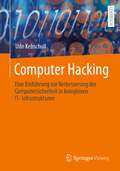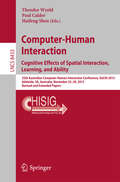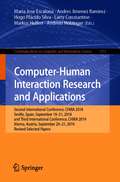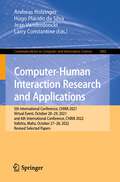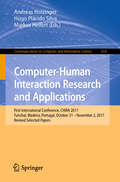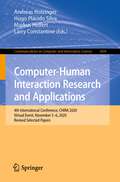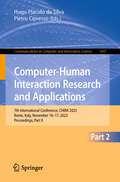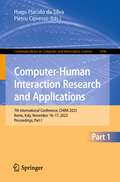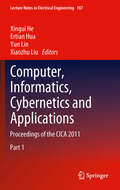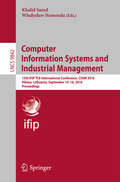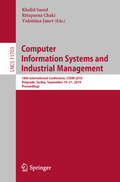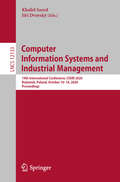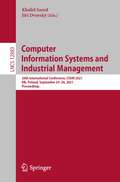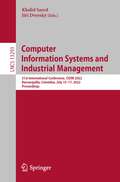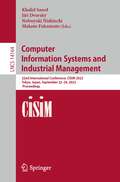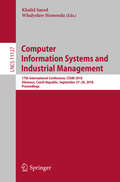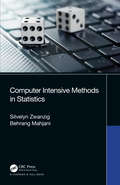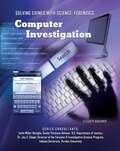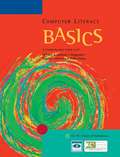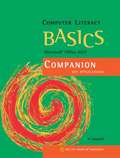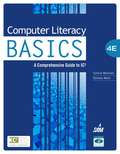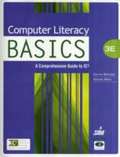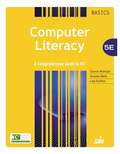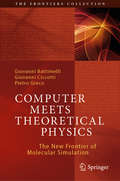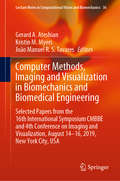- Table View
- List View
Computer Hacking: Eine Einführung zur Verbesserung der Computersicherheit in komplexen IT-Infrastrukturen
by Udo KebschullTechnische Maßnahmen, die es Cyberangreifern schwer machen, dienen zur Abschreckung, weil Hacker immer nur so hoch springen, wie sie müssen. Bei komplexen und vor allem sicherheitsrelevanten IT-Infrastrukturen reichen diese technischen Maßnahmen allein jedoch oft nicht aus.Dieses Lehrbuch betrachtet alle Aspekte der IT-Sicherheit und effektive Maßnahmen, um Angriffe zu detektieren und sich erfolgreich dagegen zu wehren. Es behandelt allgemeine Angriffsmechanismen und Angriffsszenarien, die von Angreifern angewendet werden. Dabei soll klar werden, dass es nicht ausreichend ist, Firewall-Regeln sauber zu konfigurieren oder die aktuellsten Patches einzuspielen. Vielmehr muss ein ganzheitlicher Ansatz gewählt werden, der Nutzende einschließt (Awareness) und funktionierende Prozesse für den Fall eines konkreten Angriffs etabliert. Das Buch zeigt, wo die Schwachstellen liegen, wie man sie schließt, wie man Angriffe erkennt und wie man sie erfolgreich abwehrt.
Computer-Human Interaction. Cognitive Effects of Spatial Interaction, Learning, and Ability: 25th Australian Computer-Human Interaction Conference, OzCHI 2013, Adelaide, SA, Australia, November 25-29, 2013. Revised and Extended Papers (Lecture Notes in Computer Science #8433)
by Theodor Wyeld Paul Calder Haifeng ShenThis book constitutes the thoroughly refereed post-conference proceedings of the 25th Australian Conference on Computer-Human Interaction, OzCHI 2013, held in Adelaide, SA, Australia, in November 2013. The 11 revised extended papers were carefully reviewed and selected from 192 submissions and cover topics on multi-dimensional interaction; video gaming; spatial learning; and physical spatial interaction.
Computer-Human Interaction Research and Applications: Second International Conference, CHIRA 2018, Seville, Spain, September 19-21, 2018 and Third International Conference, CHIRA 2019, Vienna, Austria, September 20-21, 2019, Revised Selected Papers (Communications in Computer and Information Science #1351)
by Maria Jose Escalona Andres Jimenez Ramirez Hugo Plácido Silva Larry Constantine Markus Helfert Andreas HolzingerThis book constitutes selected papers of the Second International Conference on Computer-Human Interaction Research and Applications, CHIRA 2018, held in Seville, Spain, in September 2018, and Third International Conference on Computer-Human Interaction Research and Applications, CHIRA 2019, held in Vienna, Austria, in September 2019.The 7 full papers presented in this book were carefully reviewed and selected from 28 submissions for CHIRA 2018 and 36 submissions for CHIRA 2019. The papers selected to be included in this book contribute to the understanding of relevant trends of current research on computer-human interaction, including Interaction design, human factors, entertainment, cognition, perception, user-friendly software and systems, pervasive technologies and interactive devices.
Computer-Human Interaction Research and Applications: 5th International Conference, CHIRA 2021, Virtual Event, October 28–29, 2021, and 6th International Conference, CHIRA 2022, Valletta, Malta, October 27–28, 2022, Revised Selected Papers (Communications in Computer and Information Science #1882)
by Andreas Holzinger Hugo Plácido da Silva Jean Vanderdonckt Larry ConstantineThis post-conference book constitutes selected papers of the Fifth International Conference on Computer-Human Interaction Research and Applications, CHIRA 2021, held virtually due to COVID 19, and Sixth International Conference on Computer-Human Interaction Research and Applications, CHIRA 2022, held in Valletta, Malta, in October 2022.The 8 full papers presented in this book were carefully reviewed and selected from 48 submissions for CHIRA 2021 and 37 submissions for CHIRA 2022. The papers selected to be included in this book contribute to the understanding of relevant trends of current research on computer-human interaction, including user-centered interaction design patterns, user experience design, multimedia and multimodal Interaction, interaction design modelling, haptic and tangible devices, accessible and adaptive interaction, user behaviour analysis, user experience evaluation, modelling human factors, mobile computer-human interaction, machine learning, information retrieval, human-centered AI and design and evaluation.
Computer-Human Interaction Research and Applications: First International Conference, CHIRA 2017, Funchal, Madeira, Portugal, October 31 – November 2, 2017, Revised Selected Papers (Communications in Computer and Information Science #654)
by Andreas Holzinger Hugo Plácido Silva Markus HelfertThis book constitutes the refereed proceedings of the First International Conference on Computer-Human Interaction Research and Applications, CHIRA 2017, held in Funchal, Madeira, Portugal, in October/November 2017.The 8 full papers presented in this book were carefully reviewed and selected from 35 submissions. The papers selected to be included in this book contribute to the understanding of relevant trends of current research on computer-human interaction, including Interaction design, human factors, entertainment, cognition, perception, user-friendly software and systems, pervasive technologies and interactive devices.
Computer-Human Interaction Research and Applications: 4th International Conference, CHIRA 2020, Virtual Event, November 5–6, 2020, Revised Selected Papers (Communications in Computer and Information Science #1609)
by Andreas Holzinger Hugo Plácido Silva Markus Helfert Larry ConstantineThis book constitutes selected papers of the Fourth International Conference on Computer-Human Interaction Research and Applications, CHIRA 2020, held virtually, in November 2020.The 8 full papers presented in this book were carefully reviewed and selected from 44 submissions. The papers selected to be included in this book contribute to the understanding of relevant trends of current research on computer-human interaction, including Interaction design, human factors, entertainment, cognition, perception, user-friendly software and systems, pervasive technologies and interactive devices.
Computer-Human Interaction Research and Applications: 7th International Conference, CHIRA 2023, Rome, Italy, November 16–17, 2023, Proceedings, Part II (Communications in Computer and Information Science #1997)
by Hugo Plácido da Silva Pietro CipressoThese 2 volumes constitute the selected papers of the 7th International Conference, CHIRA 2023, held Rome, Italy, during November 16–17, 2023.The 14 full papers and the 29 short papers presented in these books were carefully reviewed and selected from 69 submissions. The papers selected contribute to the advancement of research and practical applications of human-technology and human-computer interaction. Different aspects of Computer-Human Interaction were covered in four parallel tracks: human factors for interactive systems, research, and applications; interactive devices; interaction design; and adaptive and intelligent systems.
Computer-Human Interaction Research and Applications: 7th International Conference, CHIRA 2023, Rome, Italy, November 16–17, 2023, Proceedings, Part I (Communications in Computer and Information Science #1996)
by Hugo Plácido da Silva Pietro CipressoThese 2 volumes constitute the selected papers of the 7th International Conference, CHIRA 2023, held Rome, Italy, during November 16–17, 2023.The 14 full papers and the 29 short papers presented in these books were carefully reviewed and selected from 69 submissions. The papers selected contribute to the advancement of research and practical applications of human-technology and human-computer interaction. Different aspects of Computer-Human Interaction were covered in four parallel tracks: human factors for interactive systems, research, and applications; interactive devices; interaction design; and adaptive and intelligent systems.
Computer, Informatics, Cybernetics and Applications: Proceedings of the CICA 2011 (Lecture Notes in Electrical Engineering #107)
by Xiaozhu Liu Ertian Hua Xingui He Yun LinThe Conference on Computer, Informatics, Cybernetics and Applications 2011 aims to facilitate an exchange of information on best practices for the latest research advances in the area of computer, informatics, cybernetics and applications, which mainly includes computer science and engineering, informatics, cybernetics, control systems, communication and network systems, technologies and applications, others and emerging new topics.
Computer Information Systems and Industrial Management: 15th IFIP TC8 International Conference, CISIM 2016, Vilnius, Lithuania, September 14-16, 2016, Proceedings (Lecture Notes in Computer Science #9842)
by Władysław Homenda Khalid SaeedThis book constitutes the refereed proceedings of the 11th International Conference on Computer Information Systems and Industrial Management, CISIM 2012, held in Venice, Italy, in September 2012. The 35 revised full papers presented together with 2 keynote talks were carefully reviewed and selected from 80 submissions. The papers are organized in topical sections on security, access control and intrusion detection; pattern recognition and image processing; biometric applications; algorithms and data management; networking; and system models and risk assessment.
Computer Information Systems and Industrial Management: 18th International Conference, CISIM 2019, Belgrade, Serbia, September 19–21, 2019, Proceedings (Lecture Notes in Computer Science #11703)
by Khalid Saeed Rituparna Chaki Valentina JanevThis book constitutes the proceedings of the 18th International Conference on Computer Information Systems and Industrial Management Applications, CISIM 2019, held in Belgrade, Serbia, in September 2019. The 43 full papers presented together with 3 abstracts of keynotes were carefully reviewed and selected from 70 submissions. The main topics covered by the chapters in this book are biometrics, security systems, multimedia, classification and clustering, industrial management. Besides these, the reader will find interesting papers on computer information systems as applied to wireless networks, computer graphics, and intelligent systems. The papers are organized in the following topical sections: biometrics and pattern recognition applications; computer information systems; industrial management and other applications; machine learning and high performance computing; modelling and optimization; various aspects of computer security.
Computer Information Systems and Industrial Management: 19th International Conference, CISIM 2020, Bialystok, Poland, October 16–18, 2020, Proceedings (Lecture Notes in Computer Science #12133)
by Khalid Saeed Jiří DvorskýThis book constitutes the proceedings of the 19th International Conference on Computer Information Systems and Industrial Management Applications, CISIM 2020, held in Bialystok, Poland, in October 2020. Due to the COVID-19 pandemic the conference has been postponed to October 2020. The 40 full papers presented together with 5 abstracts of keynotes were carefully reviewed and selected from 62 submissions. The main topics covered by the chapters in this book are biometrics, security systems, multimedia, classification and clustering, industrial management. Besides these, the reader will find interesting papers on computer information systems as applied to wireless networks, computer graphics, and intelligent systems. The papers are organized in the following topical sections: biometrics and pattern recognition applications; computer information systems and security; industrial management and other applications; machine learning and high performance computing; modelling and optimization.
Computer Information Systems and Industrial Management: 20th International Conference, CISIM 2021, Ełk, Poland, September 24–26, 2021, Proceedings (Lecture Notes in Computer Science #12883)
by Khalid Saeed Jiří DvorskýThis book constitutes the proceedings of the 20th International Conference on Computer Information Systems and Industrial Management Applications, CISIM 2021, held in Ełk, Poland, September 24–26, 2021. The 38 papers presented together with 1 invited speech and 3 abstracts of keynotes were carefully reviewed and selected from 69 submissions. The main topics covered by the chapters in this book are mobile and pervasive computing, machine learning, high performance computing, image processing, industrial management. Additionally, the reader will find interesting papers on computer information systems, biometrics, security systems, and sensor network service. The contributions are organized in the following topical sections: biometrics and pattern recognition applications; computer information systems and security; industrial management and other applications; machine learning and artificial neural networks; modelling and optimization, and others.Chapter 24 "A first step towards automated species recognition from camera trap images of mammals using AI in a European temperate forest" is published open access under a CC BY license (Creative Commons Attribution 4.0 International License).
Computer Information Systems and Industrial Management: 21st International Conference, CISIM 2022, Barranquilla, Colombia, July 15–17, 2022, Proceedings (Lecture Notes in Computer Science #13293)
by Khalid Saeed Jiří DvorskýThis book constitutes the proceedings of the 21st International Conference on Computer Information Systems and Industrial Management Applications, CISIM 2022, held in Barranquilla, Colombia, in July 2022. The 28 papers presented together with 3 keynotes were carefully reviewed and selected from 68 submissions. The main topics covered by the chapters in this book are biometrics, security systems, multimedia, classification and clustering, and industrial management as well as interesting papers on computer information systems as applied to wireless networks, computer graphics, and intelligent systems.
Computer Information Systems and Industrial Management: 22nd International Conference, CISIM 2023, Tokyo, Japan, September 22–24, 2023, Proceedings (Lecture Notes in Computer Science #14164)
by Khalid Saeed Jiří Dvorský Nobuyuki Nishiuchi Makoto FukumotoThis book constitutes the proceedings of the 22nd International Conference on Computer Information Systems and Industrial Management, CISIM 2023, held in Tokio, Japan, during September 22-24, 2023. The 36 papers presented in this book were carefully reviewed and selected from 77 submissions. They were organized in topical sections as follows: biometrics and pattern recognition applications; computer information systems and security; industrial management and other applications; machine learning and artificial neural networks; modelling and optimization; wellbeing and affective engineering; and machine learning using biometric data and kansei data.
Computer Information Systems and Industrial Management: 17th International Conference, CISIM 2018, Olomouc, Czech Republic, September 27-29, 2018, Proceedings (Lecture Notes in Computer Science #11127)
by Khalid Saeed Władysław HomendaThis book constitutes the proceedings of the 17th International Conference on Computer Information Systems and Industrial Management Applications, CISIM 2018, held in Olomouc, Czech Republic, in September 2018. The 42 full papers presented together with 4 keynotes were carefully reviewed and selected from 69 submissions. The main topics covered by the chapters in this book are biometrics, security systems, multimedia, classification and clustering, and industrial management. Besides these, the reader will find interesting papers on computer information systems as applied to wireless networks, computer graphics, and intelligent systems. The papers are organized in the following topical sections: biometrics and pattern recognition applications; computer information systems; industrial management and other applications; machine learning and high performance computing; modelling and optimization; and various aspects of computer security.
Computer Intensive Methods in Statistics
by Silvelyn Zwanzig Behrang MahjaniThis textbook gives an overview of statistical methods that have been developed during the last years due to increasing computer use, including random number generators, Monte Carlo methods, Markov Chain Monte Carlo (MCMC) methods, Bootstrap, EM algorithms, SIMEX, variable selection, density estimators, kernel estimators, orthogonal and local polynomial estimators, wavelet estimators, splines, and model assessment. Computer Intensive Methods in Statistics is written for students at graduate level, but can also be used by practitioners. Features Presents the main ideas of computer-intensive statistical methods Gives the algorithms for all the methods Uses various plots and illustrations for explaining the main ideas Features the theoretical backgrounds of the main methods. Includes R codes for the methods and examples Silvelyn Zwanzig is an Associate Professor for Mathematical Statistics at Uppsala University. She studied Mathematics at the Humboldt- University in Berlin. Before coming to Sweden, she was Assistant Professor at the University of Hamburg in Germany. She received her Ph.D. in Mathematics at the Academy of Sciences of the GDR. Since 1991, she has taught Statistics for undergraduate and graduate students. Her research interests have moved from theoretical statistics to computer intensive statistics. Behrang Mahjani is a postdoctoral fellow with a Ph.D. in Scientific Computing with a focus on Computational Statistics, from Uppsala University, Sweden. He joined the Seaver Autism Center for Research and Treatment at the Icahn School of Medicine at Mount Sinai, New York, in September 2017 and was formerly a postdoctoral fellow at the Karolinska Institutet, Stockholm, Sweden. His research is focused on solving large-scale problems through statistical and computational methods.
Computer Investigation (Solving Crimes With Science: Forensics #12)
by Elizabeth BauchnerThe digital age we entered in the twenty-first century has rapidly become an age of digital crime. Cybercrimes like spoofing, phishing, and hacking are on the rise, and computer forensic technicians are on the case. Even "traditional" crimes like murder, fraud, and child abuse can be both facilitated by computers--and solved through computer investigation. Computer Investigation helps readers understand how cybercrimes are committed, and how investigators help solve them and bring the perpetrators to justice. Readers will also gain a few tips for protecting themselves online and protecting their computers from intrusions and hacks.
Computer Literacy Basics: A Comprehensive Guide to IC3
by Ann Ambrose Marly Bergerud Donald Busche Connie Morrison Dolores Wells-PusinsComputer Literacy BASICS provides an introduction to computer technology and concepts. This text maps to the IC3 standards and is organized into three key components: Computing Fundamentals, Key Applications, and Living Online. It provides thorough instruction on the various uses of the computer, important accessories, networking principles and covers key applications such as word processing, spreadsheets, and presentation applications. In addition, Computer Literacy BASICS covers e-mail and Internet principles such as managing e-mail and contacts, searching for a topic online, and how computers affect every day life. Strong end-of-chapter exercises and review material reinforce important topics covered in the lesson and allow students to demonstrate their knowledge of the material.
Computer Literacy Basics: Microsoft Office 2007 Companion
by Jennifer T. CampbellComputer Literacy BASICS: Microsoft Office 2007 Companion is designed to accompany Computer Literacy BASICS, Second Edition, providing updated coverage on Office 2007. Step-by-step instructions provide students with an overview of the Office 2007 software and will help them gain the skills necessary to pass the IC3 certification exam.
Computer Literacy Basics: A Comprehensive Guide to IC3
by Connie Morrison Dolores WellsCOMPUTER LITERACY BASICS: A COMPREHENSIVE GUIDE TO IC3 covers Computing Fundamentals, Key Applications, and Living Online - everything your students need to pass the IC3 exam, and finish the course as confident computer users.
Computer Literacy BASICS: A Comprehensive Guide to IC3
by Connie Morrison Dolores WellsBring your computer literacy course back to the BASICS. COMPUTER LITERACY BASICS: A COMPREHENSIVE GUIDE TO IC3 provides an introduction to computer concepts and skills, which maps to the newest Computing Core Certification (IC3) standards. Designed with new learners in mind, this text covers Computing Fundamentals, Key Applications, and Living Online - everything your students need to ace the IC3 exam, and finish the course as confident computer users.
Computer Literacy Basics: A Comprehensive Guide to IC³
by Connie Morrison Dolores Wells Lisa RuffoloBring your computer literacy course back to the BASICS. COMPUTER LITERACY BASICS: A COMPREHENSIVE GUIDE TO IC3 provides an introduction to computer concepts and skills, which maps to the newest Computing Core Certification (IC3) standards. Designed with new learners in mind, this text covers Computing Fundamentals, Key Applications, and Living Online - everything students need to pass the IC3 exam, and finish the course as confident computer users.
Computer Meets Theoretical Physics: The New Frontier of Molecular Simulation (The Frontiers Collection)
by Giovanni Battimelli Giovanni Ciccotti Pietro GrecoThis book provides a vivid account of the early history of molecular simulation, a new frontier for our understanding of matter that was opened when the demands of theoretical physicists were met by the availability of the modern computers. Since their inception, electronic computers have enormously increased their performance, thus making possible the unprecedented technological revolution that characterizes our present times. This obvious technological advancement has brought with it a silent scientific revolution in the practice of theoretical physics. In particular, in the physics of matter it has opened up a direct route from the microscopic physical laws to observable phenomena. One can now study the time evolution of systems composed of millions of molecules, and simulate the behaviour of macroscopic materials and actually predict their properties. Molecular simulation has provided a new theoretical and conceptual tool that physicists could only dream of when the foundations of statistical mechanics were laid. Molecular simulation has undergone impressive development, both in the size of the scientific community involved and in the range and scope of its applications. It has become the ubiquitous workhorse for investigating the nature of complex condensed matter systems in physics, chemistry, materials and the life sciences. Yet these developments remain largely unknown outside the inner circles of practitioners, and they have so far never been described for a wider public. The main objective of this book is therefore to offer a reasonably comprehensive reconstruction of the early history of molecular simulation addressed to an audience of both scientists and interested non-scientists, describing the scientific and personal trajectories of the main protagonists and discussing the deep conceptual innovations that their work produced.
Computer Methods, Imaging and Visualization in Biomechanics and Biomedical Engineering: Selected Papers from the 16th International Symposium CMBBE and 4th Conference on Imaging and Visualization, August 14-16, 2019, New York City, USA (Lecture Notes in Computational Vision and Biomechanics #36)
by João Manuel R. S. Tavares Gerard A. Ateshian Kristin M. MyersThis book gathers selected, extended and revised contributions to the 16th International Symposium on Computer Methods in Biomechanics and Biomedical Engineering, and the 4th Conference on Imaging and Visualization (CMBBE 2019), held on August 14-16, 2019, in New York City, USA. It reports on cutting-edge models and algorithms for studying various tissues and organs in normal and pathological conditions; innovative imaging and visualization techniques; and the latest diagnostic tools. Further topics addressed include: numerical methods, machine learning approaches, FEM models, and high-resolution imaging and real-time visualization methods applied for biomedical purposes. Given the scope of its coverage, the book provides graduate students and researchers with a timely and insightful snapshot of the latest research and current challenges in biomedical engineering, computational biomechanics and biological imaging, as well as a source of inspiration for future research and cross-disciplinary collaborations.
